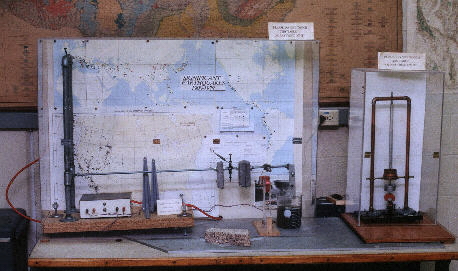Seismometers at rear of classroom/laboratory.

The long-period seismometer (left) and the short-period seismometer (right) both reside on the same steel-frame table at the rear of the Earth Science classroom. The horizontal unit responds to motions in the N-S direction, whereas the short-period unit responds to vertical motions. Students walking in the room disturb both. When they jump up and down near this table to "test" the devices, the vertical unit goes off-scale, but the horizontal unit hardly shows any affect because their jumping is a vertical motion, not horizontal, and because the jumping occurs with a short period and all short period signals are effectively suppressed within the amplifiers and by the software of the long-period system. However, when the door to the room is opened, the changed air pressure differential between the room and the hallway causes the poured concrete floor of this massive science building to flex, which shows up profoundly on the long-period unit, and hardly at all on the short period unit. Students are perplexed by the differences that they can see on the monitors at the front of the room.